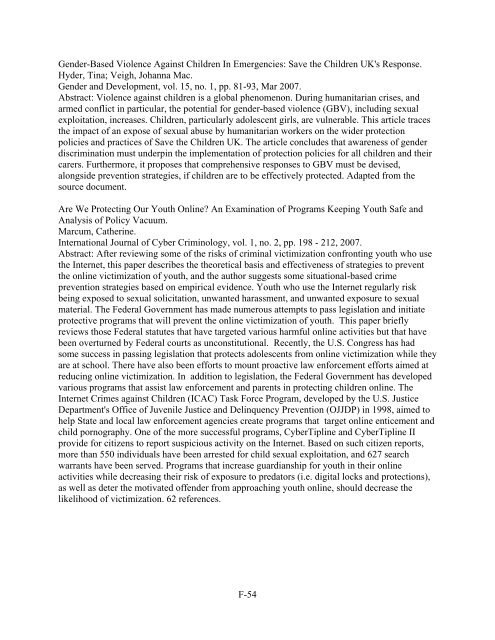The National Strategy for Child Exploitation Prevention and Interdiction
The National Strategy for Child Exploitation Prevention and Interdiction
The National Strategy for Child Exploitation Prevention and Interdiction
Create successful ePaper yourself
Turn your PDF publications into a flip-book with our unique Google optimized e-Paper software.
Gender-Based Violence Against <strong>Child</strong>ren In Emergencies: Save the <strong>Child</strong>ren UK's Response.Hyder, Tina; Veigh, Johanna Mac.Gender <strong>and</strong> Development, vol. 15, no. 1, pp. 81-93, Mar 2007.Abstract: Violence against children is a global phenomenon. During humanitarian crises, <strong>and</strong>armed conflict in particular, the potential <strong>for</strong> gender-based violence (GBV), including sexualexploitation, increases. <strong>Child</strong>ren, particularly adolescent girls, are vulnerable. This article tracesthe impact of an expose of sexual abuse by humanitarian workers on the wider protectionpolicies <strong>and</strong> practices of Save the <strong>Child</strong>ren UK. <strong>The</strong> article concludes that awareness of genderdiscrimination must underpin the implementation of protection policies <strong>for</strong> all children <strong>and</strong> theircarers. Furthermore, it proposes that comprehensive responses to GBV must be devised,alongside prevention strategies, if children are to be effectively protected. Adapted from thesource document.Are We Protecting Our Youth Online? An Examination of Programs Keeping Youth Safe <strong>and</strong>Analysis of Policy Vacuum.Marcum, Catherine.International Journal of Cyber Criminology, vol. 1, no. 2, pp. 198 - 212, 2007.Abstract: After reviewing some of the risks of criminal victimization confronting youth who usethe Internet, this paper describes the theoretical basis <strong>and</strong> effectiveness of strategies to preventthe online victimization of youth, <strong>and</strong> the author suggests some situational-based crimeprevention strategies based on empirical evidence. Youth who use the Internet regularly riskbeing exposed to sexual solicitation, unwanted harassment, <strong>and</strong> unwanted exposure to sexualmaterial. <strong>The</strong> Federal Government has made numerous attempts to pass legislation <strong>and</strong> initiateprotective programs that will prevent the online victimization of youth. This paper brieflyreviews those Federal statutes that have targeted various harmful online activities but that havebeen overturned by Federal courts as unconstitutional. Recently, the U.S. Congress has hadsome success in passing legislation that protects adolescents from online victimization while theyare at school. <strong>The</strong>re have also been ef<strong>for</strong>ts to mount proactive law en<strong>for</strong>cement ef<strong>for</strong>ts aimed atreducing online victimization. In addition to legislation, the Federal Government has developedvarious programs that assist law en<strong>for</strong>cement <strong>and</strong> parents in protecting children online. <strong>The</strong>Internet Crimes against <strong>Child</strong>ren (ICAC) Task Force Program, developed by the U.S. JusticeDepartment's Office of Juvenile Justice <strong>and</strong> Delinquency <strong>Prevention</strong> (OJJDP) in 1998, aimed tohelp State <strong>and</strong> local law en<strong>for</strong>cement agencies create programs that target online enticement <strong>and</strong>child pornography. One of the more successful programs, CyberTipline <strong>and</strong> CyberTipline IIprovide <strong>for</strong> citizens to report suspicious activity on the Internet. Based on such citizen reports,more than 550 individuals have been arrested <strong>for</strong> child sexual exploitation, <strong>and</strong> 627 searchwarrants have been served. Programs that increase guardianship <strong>for</strong> youth in their onlineactivities while decreasing their risk of exposure to predators (i.e. digital locks <strong>and</strong> protections),as well as deter the motivated offender from approaching youth online, should decrease thelikelihood of victimization. 62 references.F-54
















